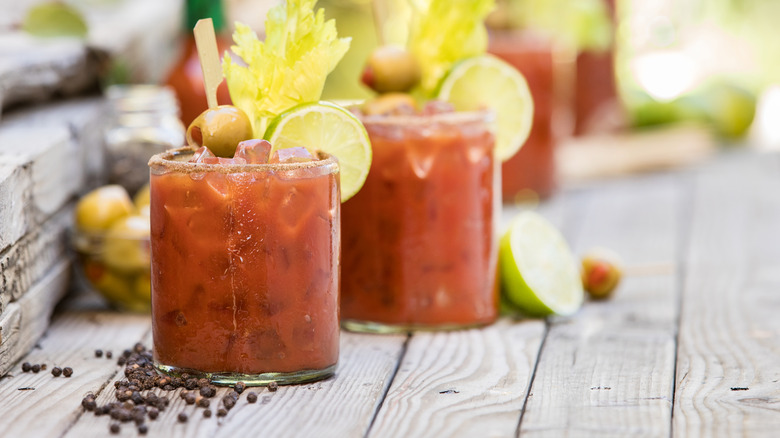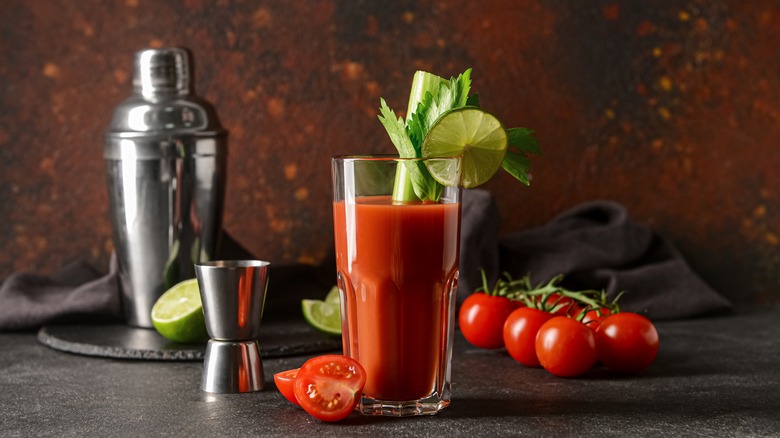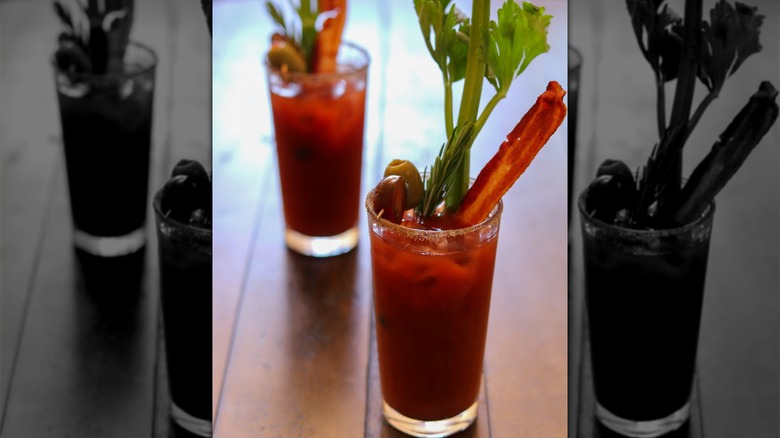What Makes A Bloody Bull Different From A Bloody Mary
Whether you regard it with revulsion or reverence, we've all heard of the Bloody Mary. This tomatoey cocktail has a reputation as both a brunch staple and a hangover cure (even though it isn't one) and divides opinion with its unique list of ingredients. There are several variations of the Bloody Mary, including the Bloody Bull.
The Bloody Bull, colloquially known as a type of "stocktail," is alleged to have first turned up in New Orleans. However, you'll want to look up the ingredients for this drink before ordering it, as it has one ingredient that makes it significantly different from a Bloody Mary.
If, for some reason, you've always thought cocktails weren't meaty enough for your taste, then you're in luck. The clue to this Bloody Mary variant's special ingredient is in the cocktail's name. Along with the cold tomato juice the Bloody Mary is known for, the Bloody Bull contains a slug of savory beef stock or bouillon.
The Bloody Mary is a savory cocktail classic
While the Bloody Mary's flavor profile is not for everyone, its savory taste certainly makes it stand out on cocktail menus that tend to be saturated with sweet and fruity drinks. Along with tomato juice, a classic Bloody Mary contains such ingredients as Worcestershire sauce, horseradish, and Old Bay seasoning, all of which you're more likely to find in a savory sauce than a typical cocktail.
The Bloody Mary is generally traced to 1921 when French bartender Fernand Petiot noticed the Russian and American clientele in Harry's New York Bar. He combined tomato juice brought over by Americans with vodka brought by Russians to develop what became the Red Snapper when it arrived in the U.S. How and when it became the Bloody Mary is unclear, with possibilities including links to a waitress named Mary who worked at Chicago's Bucket of Blood saloon, actor George Jessel naming it for his friend Mary Geraghty, or Queen Mary I of England, who was infamously known as "Bloody Mary."
Pairing a Bloody Mary is complicated. Because it's essentially soup infused with vodka, it can overpower certain dishes. For example, you probably shouldn't drink it with dessert (unless you've ordered a cheese board). A Bloody Mary is a great addition if you're having nibbles like olives or charcuterie, or with meat or fish.
Where did the Bloody Bull come from?
The Bloody Bull charged onto the scene in the 1950s, although it's somewhat uncertain where exactly it came from. Brennan's, an ornately decorated Creole restaurant that has been serving since 1946, is posited by some to be the birthplace of the Bloody Bull through its founder, Owen Brennan. However, the restaurant itself has never officially confirmed this, and it's not served on the menu.
In terms of taste, it's, for lack of a better term, beefy. If you've ever sampled that great staple of British cuisine, the Bovril Beefy Drink, you're halfway there. The seasoning hits you first with a kick from the lemon juice and Tabasco, followed by the smooth umami of Worcestershire sauce and beef stock. It is by no means an experience everyone wants from a cocktail, but enthusiasts swear by its unique taste. Some even take it a step further, adding a stout like Guinness for a seriously smooth, seriously filling end product.
Unlike the Bloody Mary, the Bloody Bull is not an ideal morning or early afternoon tipple. It's far better served with a big meaty dinner, such as a homemade burger or ribs. Predictably, it pairs particularly well with beef-based dishes like meatballs or sirloin steak.


